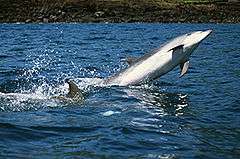Fauna of Turkey
The fauna of Turkey is abundant and very varied. The wildlife of Turkey includes a great diversity of plants and animals, each suited to its own particular habitat, as it a large country with many geographic and climatic regions About 1500 species of vertebrates have been recorded in the country and around 19,000 species of invertebrate. The country acts as a cross roads with links to Europe, Asia and the Near East, and many birds use the country as a staging post during migration.


Overview
Turkey has a large range of habitat types and the diversity of its fauna is very great. There are nearly 1,500 species of vertebrate recorded of which over 100 species, mostly fish, are endemic. The country is on two major routes used by migratory birds which swells the numbers in spring and autumn. The invertebrates are also very diverse, with about 19,000 species being recorded including 4,000 endemics.[1]
Invertebrates
Molluscs
Arachnids
Vertebrates
Reptiles
23 species are endemic.[4]
Birds
Mammals
8 species are endemic.[4] Many species have declined in numbers, for example chevrotain, gazelle and mountain sheep, with shortage of staff to protect them claimed to be a factor.[5] DNA of 15 endangered large mammals will be stored.[6]
Fish
161 species of freshwater fish are endemic.[4]
Conservation
Conservation action plans for 100 species are due to be completed by the end of 2019.[7]
Endangered species
- Mediterranean monk seal (Critically endangered) – less than 500 individuals all around the world
- Northern bald ibis (Critically endangered) – main groups live in Morocco and Turkey
- Asia Minor spiny mouse (Critically endangered)
- Rana holtzi (Toros frog; Critically endangered) – endemic to Turkey
- Pseudophoxinus maeandricus (Sandıklı spring minnow; Critically endangered) – known from a single stream.[8]
- Anatolian leopard (Endangered) – may be locally extinct[9]
- White-headed duck (Endangered)
- Red-breasted goose (Endangered)
- Loggerhead sea turtle (Endangered)
- Great bustard (Vulnerable)
- Dalmatian pelican (Vulnerable)
- Lesser kestrel (Vulnerable)
- Egyptian vulture (Vulnerable)
- Wild goat (Vulnerable)
- Greater spotted eagle (Vulnerable)
- Eastern imperial eagle (Vulnerable)
- Saker falcon (Vulnerable)
Locally extinct fauna
The following species have reportedly become extinct in Turkey, at least since the 20th century:
- Oriental darter due to the drying up of Lake Amik
- Asiatic lion[10]
- Caspian tiger, the last known one was shot in 1974 in Hakkari Province.[11]
See also
Notes
- "Biodiversity in Turkey". IUCN. 7 May 2012.
- "(PDF) First annotated checklist of the ant fauna of Turkey (Hymenoptera: Formicidae)". ResearchGate. Retrieved 2019-06-15.
- "Turkey - AntWiki". www.antwiki.org. Retrieved 2019-06-15.
- "Animals and Plants Unique to Turkey". lntreasures.com. Retrieved 2019-06-15.
- "Shortage of staff to protect wildlife in Turkey: Official - Turkey News". Hürriyet Daily News. Retrieved 2019-06-15.
- "Endangered wild animals to be protected at gene bank in Turkey". DailySabah. Retrieved 2019-06-15.
- "Thousands of wild animals back to life". Hürriyet Daily News. Retrieved 2019-06-15.
- Freyhof, J. 2014. Pseudophoxinus maeandricus. The IUCN Red List of Threatened Species. Version 2014.3. Downloaded on 20 November 2015.
- Stein, A.B.; Athreya, V.; Gerngross, P.; Balme, G.; Henschel, P.; Karanth, U.; Miquelle, D.; Rostro, S.; Kamler, J.F. & Laguardia, A. (2016). "Panthera pardus". IUCN Red List of Threatened Species. 2016.CS1 maint: ref=harv (link)
- Üstay, A. H. (1990). Hunting in Turkey. Istanbul: BBA.
- Can, Ö. E. (2004). Status, conservation and management of large carnivores in Turkey (PDF). Strasbourg: Convention on the conservation of European wildlife and natural habitats.